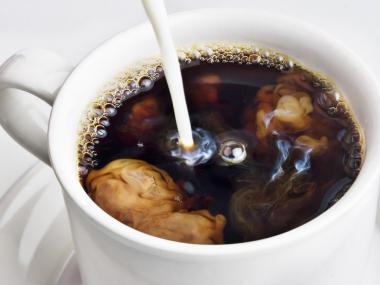4 Healthy Coffee Alternatives for Workout Energy
In this episode, I share four healthy ways to get energy without drinking a cup of coffee before your workout.

But when it comes to my pre-workout supplementation strategy, things get a bit different. I’m really not a fan of dumping a host of sympathetic nervous system “fight-or-flight” triggering compounds—including caffeine—into my body before I go pound the pavement or hit the gym. Why? I just don’t like the jittery “fake energy,” overstimulated feeling I get from using central nervous system stimulants pre-workout, and would rather not mask fatigue, push through an overtrained body when I’m tired and should perhaps instead be taking a nap or doing yoga. Plus, I just don’t want to overstimulate my adrenal glands with excessive caffeine. After all, my morning cup of coffee is pretty dang large, and repeating that process in the afternoon could possibly become excessive, although my guest in the podcast episode “63 Cups Of Coffee A Day & More: Five Simple Things You Can Do to Live a Longer, Healthier Life” might argue otherwise.
So when I read this most recent study, “Effect of Coffee and Caffeine Ingestion on Resistance Exercise Performance,” I didn’t necessarily go out and grab the nearest cappuccino. Sure, the study points out something I’ve highlighted in my previous Get-Fit Guy article “Can Caffeine Help You Workout?”—the fact that the equivalent of two cups of coffee (and even decaffeinated coffee with caffeine added to it) has the ability to improve performance during a hard resistance exercise protocol. But the study got me thinking about ways that one could perhaps reap the same exercise enhancing benefits without necessarily taxing the nervous system with too much caffeine.
I came up with four healthy pre-workout alternatives to coffee.
Peppermint Oil
I first reported on this peppermint oil “trick” in my article “Mint-Chocolate Water, Upper Lip Peppermint Sniffing, Peppermint Fat Bombs & More: How Peppermint Can Enhance Performance.” Peppermint oil has been extensively.studied for its benefits in athletic performance.
One recent study included 30 healthy male university students randomly divided into an experimental group of oral administration of peppermint oil and a control group. The study aimed to determine if ingestion of peppermint oil modulated physiological parameters and exercise performance after 5 minutes and 1 hour. The authors measured maximum isometric grip force, vertical and long jumps, spirometric parameters, visual and audio reaction times, blood pressure, heart rate, and breath rate.
Another study examined the response of 12 male students after 10 days of supplementation with peppermint oil in water. This study also supported the effectiveness of peppermint essential oil on the exercise performance, gas analysis, spirometry parameters, blood pressure, and respiratory rate in the young male students.
Finally, a third study in 2001 demonstrated that the impact of peppermint odor during exercise in 40 adults improved running speed, hand-grip strength, and number of push-ups verses the non-odor exposed control subjects.
In yet another study, menthol’s cooling effect was assessed by evaluating cycling performance in 12 males in a tropical climate. The athletes “drank 190 mL of either aromatized (i.e., with 0.5 mL of menthol (5 gr/mL) or a non-aromatized beverage (neutral temperature: 23°C±0.1°C, cold: 3°C±0.1°C, or ice-slush: 1°C±0.7°C)…” and researchers concluded, “Cold water or ice-slush with menthol aroma seems to be the most effective beverage for endurance exercise in a tropical climate.”
So how should you use peppermint to enhance your workout? I’d recommend you start simple: just smear a bit of peppermint essential oil on your upper lip before your next hard workout. By the way, that last study about the cooling effect of a mint ice slushy brings me to my next tip: pre-cooling.
Pre-Cooling
The relatively recent paper Precooling methods and their effects on athletic performance : a systematic review and practical applications. investigated the application (external, including cold shower, cold baths, cold plunges, etc) and ingestion (internal, including ice slushies, cold icewater, etc.) of cold modalities including air, water and/or ice, separately or in combination, immediately prior to exercise. The study reports “…clear evidence of the benefits for a range of precooling strategies undertaken in the laboratory setting exists, which suggest that these strategies could be employed by athletes who compete in hot environmental conditions to improve exercise safety, reduce their perceived thermal stress and improve sports performance.”
So what does this mean for you?
The next time time you have a hard workout planned, you can try jumping into a cold shower at the gym, drinking a very cold ice slushy (yes, I suppose it could even be a frappuccino-esque drink if you really must have your coffee too), or even preceding something like a strength training workout with a “warm-up” (yes, I realize the term is ironic in this case) swim in slightly chilly water.
The benefits, as you learn in my last Get-Fit Guy episode on cold thermogenesis include a release of nitric oxide (which is like a full body Viagra equivalent!), increased blood flow, the ability to push yourself to higher levels of fatigue post-cooling, an increase in conversion of white-fat based storage adipose tissue to brown-fat based metabolically active tissue and much more.
Brain Stimulation
The “New Yorker” recently released an article entitled “For The Golden State Warriors, Brain Zapping Could Provide An Edge.” In the article, the author reports how one of the world’s best professional basketball teams uses special headphones designed to “accelerate gains in strength, explosiveness, and dexterity” through a technique called “neuropriming.”
The headphones use a form of electrical brain stimulation called transcranial direct-current stimulation, or tDCS, which basically involves attaching a couple of electrodes to a battery, sticking them to one’s head, and sending a mild current about five hundred to a thousand times smaller than that used in electroshock therapy through one’s brain. The current changes the excitability of individual neurons in the brain, making them slightly more or less likely to fire (a “neuropriming” effect). The electrodes are positioned to send a current through your brain’s motor cortex, where commands to your muscles originate. The strategy behind using such a device is that if you wear the headphones for twenty minutes during a pre-workout warmup, your brain will deliver “stronger, more synchronous” signals to your muscles.
And research backs this up. In 2007, Italian researchers proved that stimulating the motor cortex reduced neuromuscular fatigue and increased endurance. In a later Brazilian study, stimulating specific areas of the brain boosted endurance performance in cycling. And a quick Pubmed search for tDCS reveals that in the past five years alone, researchers have published more than two thousand studies exploring electrical stimulation’s potential for enhancing everything from learning to fighting addiction and depression to improving walking ability in patients with Parkinson’s disease and beyond.
As for me personally, I’ve been experimenting with a slightly different form of electrical stimulation called “neurofeedback”, in which I attach a series of wires to my head and fly virtual spaceships while staring at a computer screen. The path and efficiency of the spaceship changes depending on whether I’m producing “stressful” fast beta brain waves, “focused” alpha brain waves or “relaxed” theta brain waves. To learn exactly how this method works, I’d recommend you visit the Peak Brain Institute (based in Los Angeles), where I traveled to train and personally learn this technique. And yes, I’ll be releasing a podcast soon on the results, which thus far have been quite good for everything from pre-workout to focus to decreased distractibility to sleep.
Music
And finally we come to one of my favorite pre-workout priming techniques: music. The mechanisms of how music motivates you to exercise harder are actually not entirely clear. However, it is suspected by music researchers that there are two elements at play:
-
The ability of music to distract your attention on pain and fatigue, which could be described as a psychological effect; and
-
The ability of music to increase heart rate and breathing, which could be called the physiological effect.
In the Get-Fit Guy episode Do Workout Songs and Music Make You Exercise Harder?, I report on a study in which researchers had twelve men ride a bike while listening to music. During each 25 minute bicycling session, the researchers adjusted the tempo of the music to go 10% faster or 10% slower. They found that speeding up the music program increased how far the participants rode and how hard and how fast they pedaled, and slowing down the music had just the opposite effect! Interestingly, the study participants actually reported liking the music more when it was played at a faster tempo.
A 2008 study that was also performed on cyclists found that it was far easier for the cyclists to pedal when they were following the tempo, or beat, of the music. Another 2009 study found that basketball players could shoot better free throws when they listened to catchy, upbeat music. Researchers have suggested that the same positive distraction that helped those basketball players shoot better can also distract us from fatigue or pain experienced during exercise.
In yet another 2003 study, researchers observed that people who listened to music during exercise actually improved their mood, the speed of their decision-making processes, and even their verbal fluency. That means you’ll not only be able to exercise harder when you listen to music, but you may actually get smarter too!
But beware: once you get up to very high intensities, studies have shown that music doesn’t provide any additional benefit, so if you’re trying to set a marathon world record, sneaking in a pair of headphones probably won’t help. And also beware that participants playing music on headphones is outlawed in many sporting events.
Summary
So that’s it! What are you waiting for? Smear some peppermint oil on your upper lip, take a cold shower, strap fancy electrodes to your head, tune into some upbeat music or try all four at once (if you dare!), and perhaps you can completely forsake any pre-workout caffeine loading.
Do you have questions, comments or feedback about these four healthy pre-workout alternatives to coffee? Then join the conversation over at Facebook.com/getfitguy.






